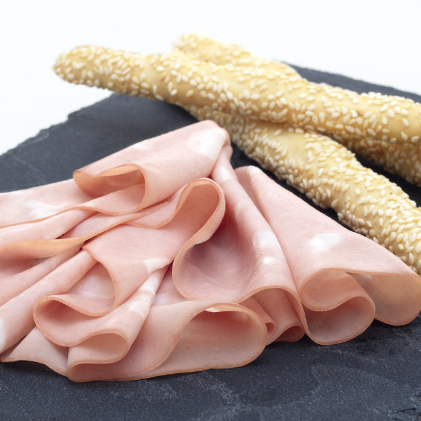La Bulåggna
Mortadella Bologna PGI
History
Mortadella Bologna is a product with centuries of history, and considered the most famous cured meat in the whole gastronomic tradition of the city of Bologna.
But what are its origins?
We have to go back to the lands of ancient Etrurian Felsina and Gallic Bonimia, with plenty of oak forests providing tasty acorns to the local wild pigs. It is exactly from these pigs that Mortadella Bologna’s tradition started.


There are two hypothesis on the name’s origin:
1) In the Archeological Museum of Bologna is preserved the first record of what is believed to have been a Mortadella producer: a stone from Roman Imperial Era, carved with the picture of seven pigs on one side, and a mortar and pestle on the other. Since mortar was used by Ancient Romans to tenderize and knead pork’s meat together with salt and spices, it could be that Mortadella’s name comes from “mortarium” or “murtatum”, meaning exactly “meat minced in the mortar”.
2) The second hypothesis focuses on the world “myrtatum”, which in latin means myrt. This herb was the key ingredient for a sausage called farcimen myrtatum. Clearly it was a rather famous recipe, since both Plinio il Vecchio and Varrone mention it.
The first real Mortadella’s recipe was written by agronomist Vincenzo Tanara at the beginning of XVII century, also giving precise instructions for the ingredients. The amount of fat in that first recipe was way superior than today.
In 1661 it was officially recognized product’s uniqueness and its exclusivity tied to the city of Bologna, thanks to cardinal Farnese which published a document which codified the production of Mortadella. It is one of the first examples of disciplinary similar to the ones we have today for geographical indications’ certificates.
Some centuries ago Mortadella Bologna was a product reserved to a noble and rich élite, the only ones that could afford a rather expensive charcuterie. It was only after the gradual development of processed meats’ industry, which began in XIX century, that Mortadella Bologna became a product from anyone, democratic and popular: Italy’s most loved!

Disciplinary
Many tries, very few succed: the name “Mortadella Bologna PGI” is not for everyone. This protected geographical indications is in fact destined only for the few charcuterie products that respect all conditions and requirements established in the Production Disciplinary.
The stricts requirements cover all aspects, like:
- Areas of production
- Raw materials and meat cuts
- Processing
- Organoleptic, chemical and physical characteristics
- Controls


Production
Did you know that at FICO Eataly World there is the first transparent
factory of Mortadella Bologna PGI?
Here you can be a spectator of bagging, binding, stewing and showering phases,
the most important in the whole production process.
Meat cuts are mainly from the pork’s shoulder, and are carefully selected, minced and
mixed with lardon, spices and natural aroma. For the lardons, the tastier cut of the
whole pig is used: neck fat.
The mixture is then bagged and cooked in particular stoves for several hours,
depending on weight (usually between 8 and 26 hours), until Mortadella’s heart
reaches a temperature of 70°. This is the most delicate phase,
because it gives Mortadella Bologna PGI its scent and softness.
The last phase is the showering one, followed by cooling down.
All this, together with high quality selected ingredients, brings uniqueness
to the product.
The quality level we reached in the ingredient selection and processing techniques
allow us to produce Mortadella rich in protein and suited for the modern consumer’s needs.
Cut
Cutting your Mortadella is a form of art. Here’s how to do it!

1. Cut must commence from the pointed end, because the rounded one is generally softer due to fat migrating.
2. Procede by removing rope and skin from portions of 5 cm at a time, to avoid drying. Discard the first couple of cm of product. Position the Mortadella on the slicing machine paying attention that it adheres perfectly; now you can start cutting.
3. Arrange slices in a orderly manner, wrapping them in paper and avoiding to press or push them.
4. If you want to obtain cubes, thickness depends on required weight and it is recommended to dice the product right before serving. If you prefer triangular slices, start from a thick cylindrical one and cut it in cloves.



